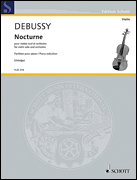Debussy, Claude (Orledge) Nocturne
Violin Solos w/Piano

-
Debussy, Claude (Orledge)
Nocturne (Orledge)
The Belgian violinist Eugene Ysaye (1858-1931), with his impressive blend of virtuosity and poetry, was a great admirer of the young Debussy's music who led the Paris premiŠre of his only string quartet in December 1893. In September 1892, Debussy was planning an American tour with the financial support of Prince Andr‚ Poniatowski that was to include his nearly completed three ScŠnes au cr‚puscule, inspired by the Symbolist poetry of his friend Henri de R‚gnier. He made extensive revisions to them in 1893, even if all that seems to have survived is a series of sketches in BibliothŠque Nationale de France, MS 20632(2), most of which appear to be for violin and orchestra in E or B major. Another related, and more virtuosic, theme emerged in a Parisian sale in June 2006, which opens the main part of the present Nocturne (after a slow introduction).We also learn from Ernest Chausson in April 1893 that Debussy was composing a work for Ysa˜e's first American tour in 1894-95, whichat one stage was described as a concerto. Then, as Debussy was putting the finishing touches to L'AprŠs-midi d'un faune in1894, he told Ysa˜e he was now working on three Nocturnes for solo violin and orchestra which are destined for you, and which undoubtedly derived from his earlier Twilight scenes. The first was to be for strings only; the second for three flutes, four horns, three trumpets and two harps; the third combines all these instruments. He also informed Ysa˜e, perhaps with Whistler's Nocturnes in mind, that they were to be like a study in grey in painting. Debussy only abandoned this project in November 1896 after Ysa˜e told him he would not be able to premiŠre the Nocturnes in Brussels for financial reasons?.
My completion comes closest to the third Nocturne Debussy planned and to being a rondo with related episodes. The dynamic idea that emerged in 2006, which was scored by Debussy, leads naturally into the twilight?theme in B major beginning on solo cello and double basses, with the high, haunting three-note idea first heard at the outset floating above on solo violin, exactly as Debussy conceived it. All five of Debussy's themes are harmonized and they vary in length between three and thirteen bars: noneof them relate to the orchestral Nocturnes of 1897-99. -Robert Orledge
-
- Category: Violin Solos w/Piano
- Item: 123253
- Grade/Level:
- Price: $26.99
-
(usually ships in 24 hours)
